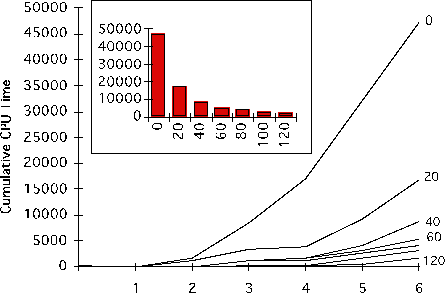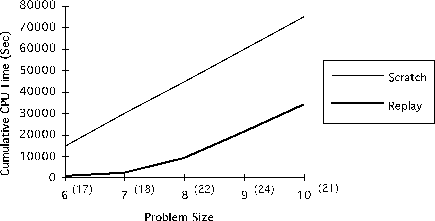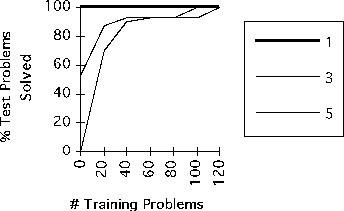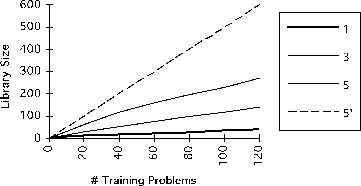 |
| Phase | 20 | 40 | 60 | 80 | 100 | 120 | |
| One Goal | |||||||
|---|---|---|---|---|---|---|---|
| %Solved | 100%(3) | 100%(3) | 100%(3) | 100%(3) | 100%(3) | 100%(3) | 100%(3) |
| time(sec) | 15 | 14(.1) | 13(.1) | 4(.0) | 5(.10) | 3(.13) | 3(.13) |
| Two Goal | |||||||
| % Solved | 90%(4) | 93%(4) | 100%(5) | 100%(5) | 100%(5) | 100%(5) | 100%(5) |
| time(sec) | 1548 | 1069(.2) | 22(1.0) | 23(.2) | 25(.28) | 15(.28) | 11(.26) |
| Three Goal | |||||||
| % Solved | 53%(5) | 87%(7) | 93%(7) | 93%(7) | 93%(7) | 100%(8) | 100%(8) |
| time(sec) | 7038 | 2214(.55) | 1209(.49) | 1203(.54) | 1222(.52) | 250(.54) | 134(.58) |
| Four Goal | |||||||
| % Solved | 43%(5) | 100%(8) | 100%(8) | 100%(8) | 100%(9) | 100%(9) | 100%(9) |
| time(sec) | 8525 | 563(.99) | 395(.79) | 452(.91) | 24(.97) | 22(.89) | 22(.88) |
| Five Goal | |||||||
| % Solved | 0% | 70%(11) | 90%(11) | 93%(11) | 93%(11) | 93%(11) | 100%(12) |
| time(sec) | 15000 | 5269(2) | 2450(1) | 1425(2) | 1479(1) | 1501(1) | 375(1) |
| Six Goal | |||||||
| % Solved | 0% | 50%(12) | 70%(13) | 87%(14) | 93%(14) | 93%(14) | 93%(14) |
| time(sec) | 15000 | 7748(3) | 4578(5) | 2191(5) | 1299(3) | 1319(3) | 1244(3) |
 |
 |
 |
 |
In the first experiment on the 6 city domain DERSNLP+EBL showed substantial improvements with multi-case replay as evident from the results in Table 4. Moreover, replay performance improved with problem-solving experience. The plans that were produced showed only a slight increase in number of steps over the solutions which were obtained in from-scratch mode. The same results are plotted in Figure 17 which graphs cumulative CPU time on all test problems over the six experiments. This figure illustrates how CPU time decreased with the number of training problems solved. The insert shows total CPU time (including case retrieval time) for all of the test problems in the six experiments. As evident in this insert, planning performance improves with increased experience on random problems. However, relatively little experience (20 problems solved) was enough to show significant performance improvements.
Replay raised the problem-solving
horizon, as illustrated in
Figure 19. It is more effective with larger problem size,
when from-scratch planning tends to exceed the time limit imposed on
problem-solving.
Figure 20 shows the increase in the size
of the library with increasing amounts of training. This
figure also indicates that library size
is determined more by the amount of interaction in the domain,
as opposed to the number of training problems solved.
The rate at which the case library grows tapers off and
is higher when the planner
is trained on larger problems![[*]](foot_motif.gif) .
.
In the second experiment,
a library formed over the course
of training on 6-goal problems was used to solve larger problems
(6 to 10 goals) in a more complex domain (15 cities)
(See Figure 18).
None of the larger problems were solved in from-scratch mode
within the time limit of 500 sec ![[*]](foot_motif.gif) .
The planner continued to maximum time on all problems,
indicated in the figure by the linear increase in CPU time.
Its performance was
substantially better with replay, however. Since library size was relatively
small,
the improvements in planning performance
more than offset the cost of retrieving and adapting previous cases.
This finding suggests that the replay strategy employed in these
experiments represents an effective method
for improving planning performance in complex domains.
.
The planner continued to maximum time on all problems,
indicated in the figure by the linear increase in CPU time.
Its performance was
substantially better with replay, however. Since library size was relatively
small,
the improvements in planning performance
more than offset the cost of retrieving and adapting previous cases.
This finding suggests that the replay strategy employed in these
experiments represents an effective method
for improving planning performance in complex domains.